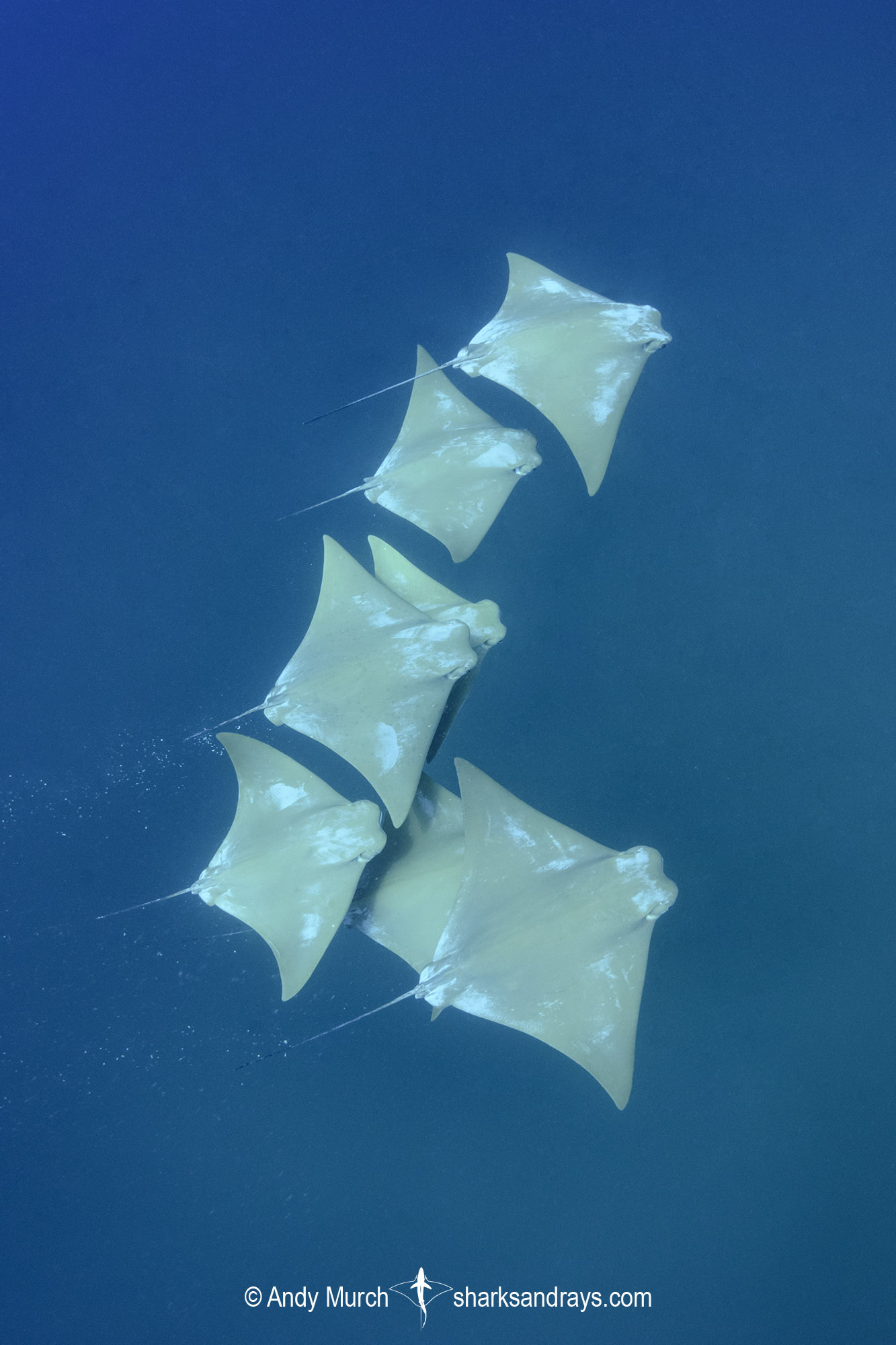Common name(s)
Atlantic Cownose Ray, American Cownose Ray.
Identification
A large cownose ray with a wide, kite-shaped disc and a bulbous, protruding head. Snout notched. Cephalic lobes short; posterior edges barely reaching mouth. Lobes fit into a shallow groove when not in use. Spiracles located over pectoral fin margins.
Anterior margins of pectoral fins straight or mildly sinuous. Posterior margins of pectoral fins concave. Pectoral fin insertions deep. Pelvic fins posterior margins convex; extending slightly posterior to disc. Dorsal fin well developed, with a weakly concave posterior margin. Dorsal fin origin midway between pectoral fin insertion and pectoral free rear tip. Tail long, thin, and whiplike; 2-2.3 x disc length when intact. Thick ventral finfold present on anterior tail. Caudal sting well developed but often missing.
Colour
Dorsum mid to dark brown or or greenish grey, without markings. Cephalic lobes often darker. Ventrum mostly white with dusky pectoral fin apices. Posterior portion of tail dark ventrally.
Size
Maximum disc width 110cm. Disc width at birth 20-43cm.
Habitat
Bentho-pelagic in tropical and warm temperate seas. Often found in huge schools. Mainly inshore bays and seagrass beds, but also offshore.
Distribution
Western Atlantic. Occurs inshore from Massachusetts to Uruguay, including the Gulf of Mexico and northern Caribbean. Absent from the Caribbean chain south of Cuba.
Conservation Status
VULNERABLE
The American Cownose Ray is among the least productive elasmobranchs with a generation length of 14 years and an estimated median intrinsic rate of population growth rate r = 0.008. It is an opportunistic predator of benthic invertebrates but in the United States has long been persecuted due to perceptions they feed primarily on commercial bivalves leading to claims they led to the collapse of commercial bivalve populations along the USA East Coast through a trophic cascade. This led to the development of the ‘Save the Bay, Eat a Ray’ fishery which was promoted by state fishery managers, seafood companies, some environmental organizations and local ‘eco-friendly’ restaurants as well as the development of tournaments to cull the “nuisance” cownose rays. Whereas American Cownose Ray did prey on historically abundant soft-shell clams (Mya spp.), other commercial bivalves make up a very small proportion of the diet and collapse of the bivalve stocks were primarily due to overfishing and other causes. Following the publication of a rebuttal of the trophic cascade and the implication that American Cownose Rays caused the collapse of shellfish populations, the ‘Save the Bay, Eat a Ray’ campaign has declined in popularity. In the Gulf of Mexico, a relative abundance time-series of a fishery-independent demersal trawl survey reveals that the population increased through 1987–2010 and has been declining ever since yet the overall estimated annual rate of increase is 2.5% but while the probability of Least Concern is 83% there is a 14% probability that the population is threatened. In the southern Caribbean and Southwest Atlantic, commercial and artisanal fisheries are intense, unmanaged, and have led to steep declines in other species, and there is no reason to suspect that this species has also not been reduced in numbers in that area. For example, there is a long history photographic records of past landings of schools of Rhinoptera bonasus/brasiliensis but they have completely disappeared from recent fishery landings in Venezuela. Due to the level of exploitation by widespread artisanal fisheries and in some areas commercial fisheries, which lack adequate management, it is suspected that this species has undergone a population reduction of >80% over the past three generation lengths (43 years) in that part of its range. Due to the increasing abundance in the Northwest Atlantic and Gulf of Mexico, combined with suspected steep reductions in population size in the southern Caribbean and Southwest Atlantic, it is suspected that the American Cownose Ray has undergone an overall population reduction of 30–49% over the past three generation lengths (43 years), and it is assessed as Vulnerable A2d.
Citation
Carlson, J., Charvet, P., Avalos, C., Blanco-Parra, MP, Briones Bell-lloch, A., Cardenosa, D., Crysler, Z., Derrick, D., Espinoza, E., Morales-Saldaña, J.M., Naranjo-Elizondo, B., Pacoureau, N., Pérez Jiménez, J.C., Schneider, E.V.C., Simpson, N.J. & Dulvy, N.K. 2020. Rhinoptera bonasus. The IUCN Red List of Threatened Species 2020: e.T60128A3088381. https://dx.doi.org/10.2305/IUCN.UK.2020-3.RLTS.T60128A3088381.en. Downloaded on 16 March 2021.
Reproduction
Aplacental viviparity. One pup per litter. Gestation 11-12 months.
Diet
Diet mainly consists of benthic invertebrates. Large schools of cownose rays have been implicated in damage to seagrass beds.
Behavior
An active swimmer that is usually found in small groups or extremely large aggregations numbering in the thousands.
Off the coast of Florida, Atlantic cownose rays are found in mixed schools with Brazilian cownose rays (Dr. Gregg Poulakis pers. corr.).
Reaction to divers
Difficult to approach but sometimes seen in enormous schools come very close to boats.
Diving logistics
Divers often run into schooling cownose rays when looking for whale sharks in the southern Gulf of Mexico, and in the Atlantic close to the Yucatan Peninsula. They are probably common throughout coastal Mexico and the southern USA but more divers see them in the Gulf and Yucatan, likely just because there are seasonally more divers in the water in those areas.
Further north, there are many reports of Atlantic cownose rays in Chesapeake Bay during the summer months but the reports are mainly from fishermen. Viz in the bay is often challenging for underwater encounters.



